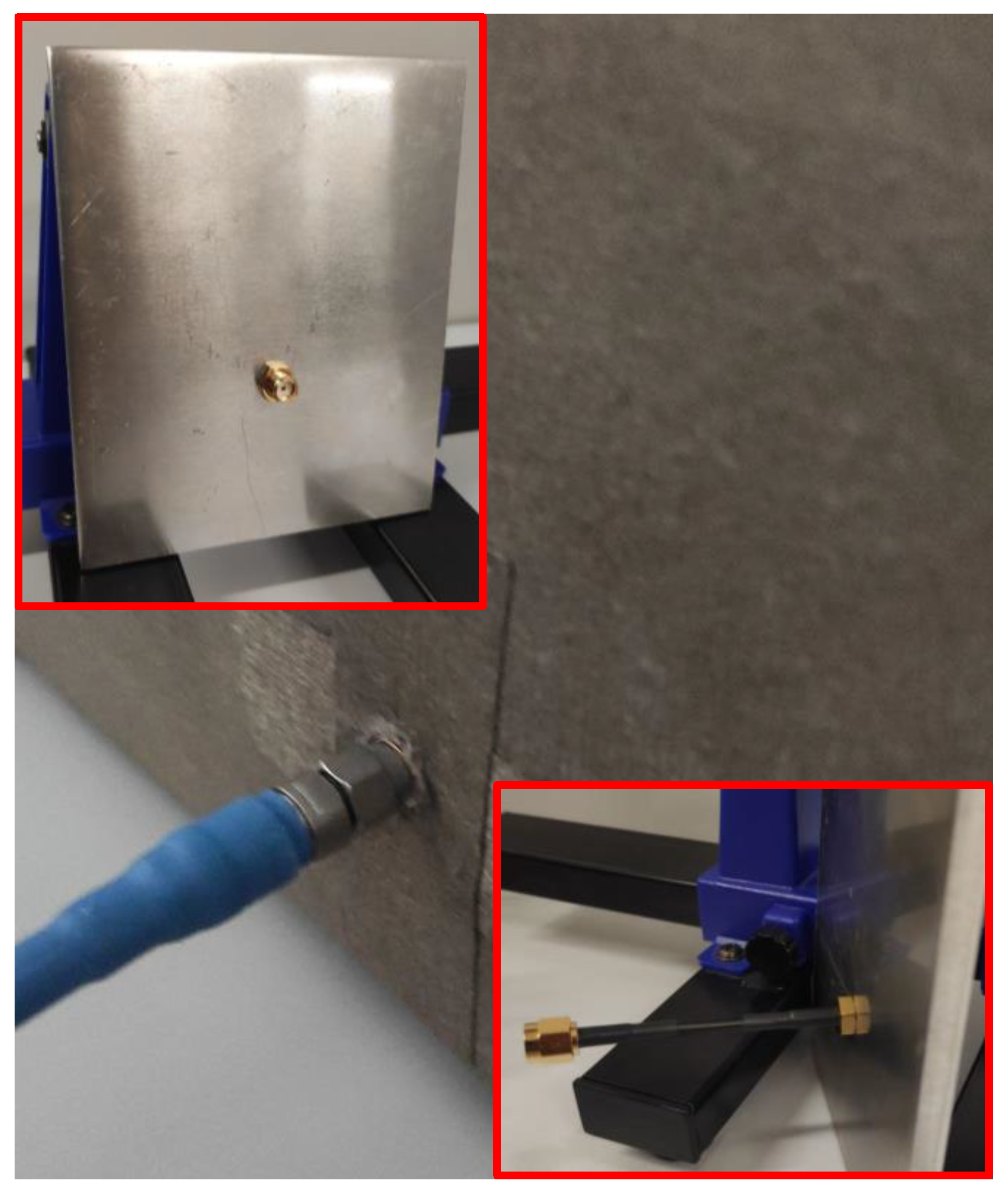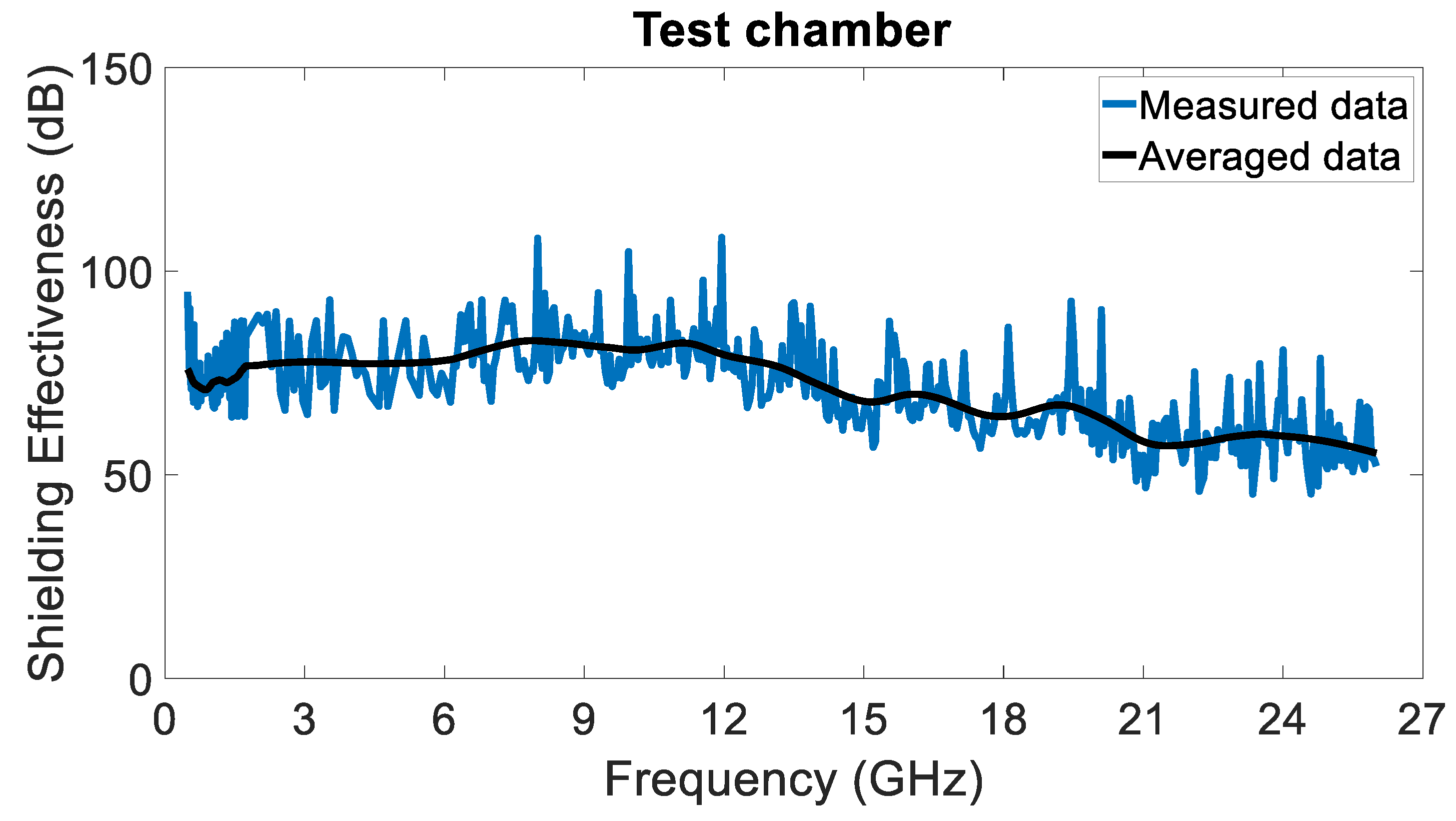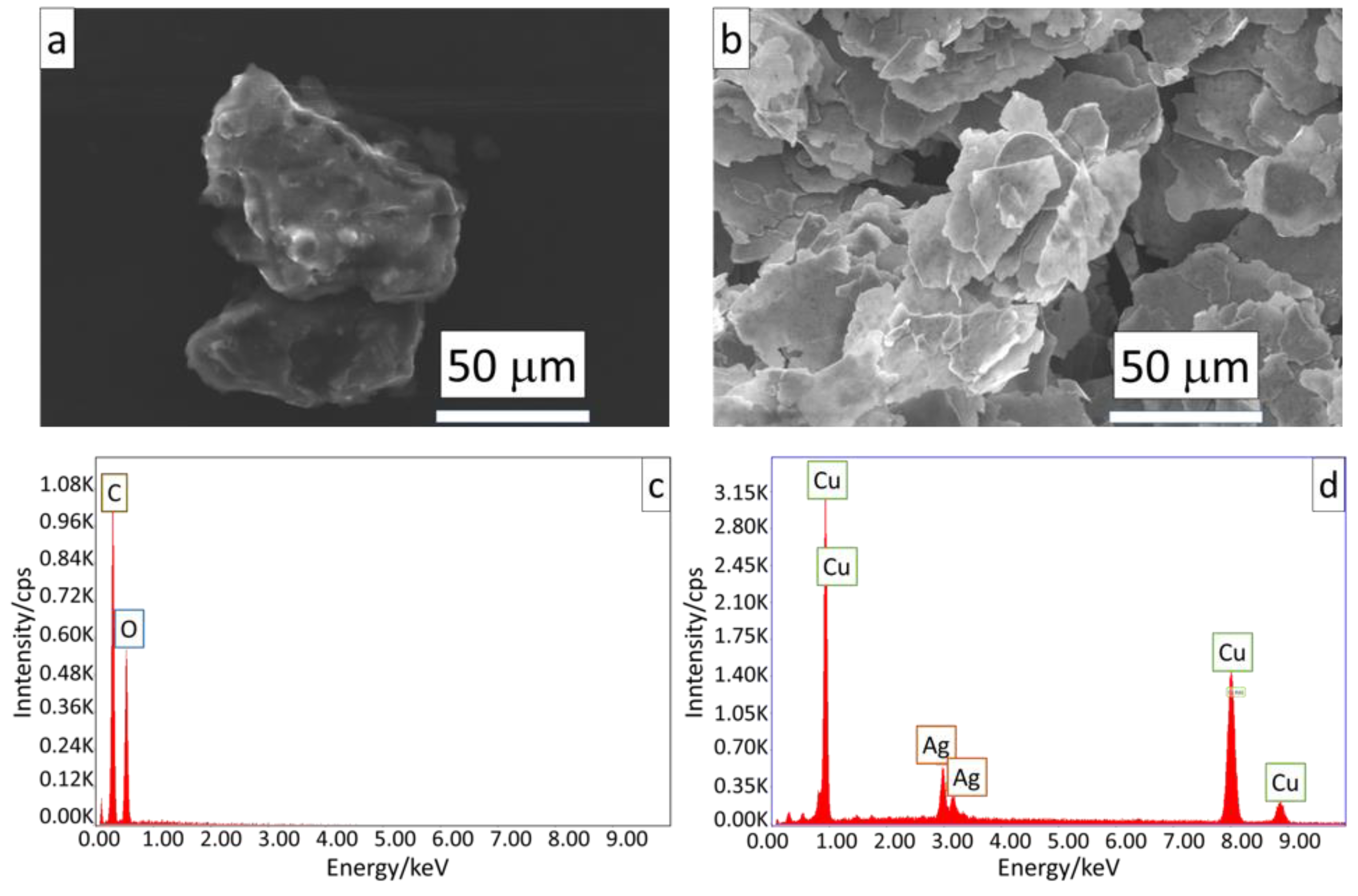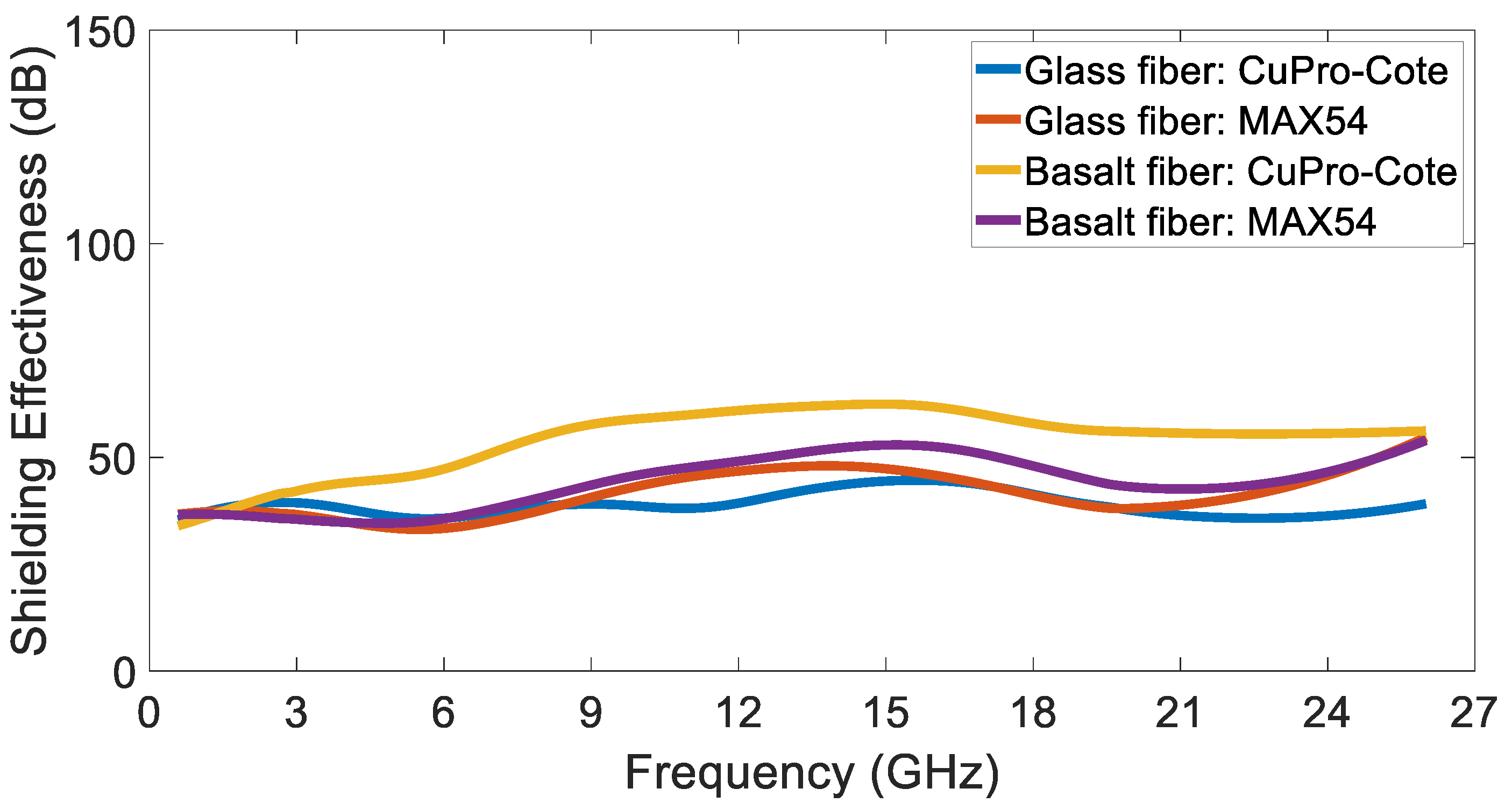Development of a Simple Setup to Measure Shielding Effectiveness at Microwave Frequencies
Abstract
1. Introduction
2. Construction of the Anechoic Shielded Chamber
3. Measurement Setup and Performance of the Chamber
4. Test of Commercial Coating
5. Conclusions
Author Contributions
Funding
Institutional Review Board Statement
Informed Consent Statement
Data Availability Statement
Conflicts of Interest
References
- Ardila-Rey, J.A.; De Castro, B.A.; Rozas-Valderrama, R.; Orellana, L.; Boya, C.; Muhammad-Sukki, F.; Mas’ud, A.A. Variation in the spectral content of UHF PD signals due to the presence of obstacles in the measurement environment. IEEE Sens. J. 2023, 23, 22620–22629. [Google Scholar] [CrossRef]
- Cardillo, E.; Ferro, L.; Sapienza, G.; Li, C. Reliable eye-blinking detection with millimeter-wave radar glasses. IEEE Trans. Microw. Theory Tech. 2024, 72, 771–779. [Google Scholar] [CrossRef]
- Ahn, J.; Woo, S.; Kim, H.; Song, K.; Huh, S.; Hong, S.E.; Kim, J.; Choi, H.D.; Ahn, S. An out-of-phase wireless power transfer system for implantable medical devices to reduce human exposure to electromagnetic field and increase power transfer efficiency. IEEE Trans. Biomed. Circuits Syst. 2022, 16, 1166–1180. [Google Scholar] [CrossRef]
- Yao, C.-Y.; Liao, W.-J. An estimation method for EMI radiated emissions using measured source voltages. IEEE Trans. Electromagn. Compat. 2023, 65, 770–779. [Google Scholar] [CrossRef]
- Matsumoto, Y.; Gotoh, K.; Yamanaka, Y. Effects of increasing number of disturbance sources on the setting of emission limits. IEEE Trans. Electromagn. Compat. 2023, 65, 982–996. [Google Scholar] [CrossRef]
- Li, R.; Yue, Y.; Song, X.; Ji, S. Measurement and prediction of indoor wideband electric field radiation. IEEE Trans. Instrum. Meas. 2021, 70, 6504612. [Google Scholar] [CrossRef]
- Scandurra, G.; Arena, A.; Cardillo, E.; Giusi, G.; Ciofi, C. Portable and highly versatile impedance meter for very low frequency measurements. Appl. Sci. 2021, 11, 8234. [Google Scholar] [CrossRef]
- Cardillo, E.; Sapienza, G.; Ferro, L.; Li, C.; Caddemi, A. Radar assistive system for people with neurodegenerative disorders through head motion and eyes blinking detection. In Proceedings of the 2023 IEEE/MTT-S International Microwave Symposium—IMS 2023, San Diego, CA, USA, 11–16 June 2023; pp. 979–982. [Google Scholar] [CrossRef]
- Scandurra, G.; Cardillo, E.; Giusi, G.; Ciofi, C.; Alonso, E.; Giannetti, R. Portable knee health monitoring system by impedance spectroscopy based on audio-board. Electronics 2021, 10, 460. [Google Scholar] [CrossRef]
- Cardillo, E.; Ferro, L.; Li, C. Microwave and millimeter-wave radar circuits for the next generation contact-less in-cabin detection. In Proceedings of the APMC 2022, Yokohama, Japan, 29 November–2 December 2022; pp. 231–233. [Google Scholar] [CrossRef]
- Cardillo, E.; Li, C.; Caddemi, A. Heating, ventilation, and air conditioning control by range-Doppler and micro-Doppler radar sensor. In Proceedings of the European Radar Conference, London, UK, 5–7 April 2022; pp. 21–24. [Google Scholar] [CrossRef]
- Campi, T.; Cruciani, S.; Maradei, F.; Feliziani, M. Electromagnetic interference in cardiac implantable electronic devices due to dynamic wireless power systems for electric vehicles. Energies 2023, 16, 3822. [Google Scholar] [CrossRef]
- Anzaldi, G.; Silva, F.; Fernandez, M.; Quilez, M.; Riu, P.J. Initial analysis of SAR from a cell phone inside a vehicle by numerical computation. IEEE Trans. Biomed. Eng. 2007, 54, 921–930. [Google Scholar] [CrossRef]
- Narayanan, S.; Zhang, Y.; Aslani, F. Prediction Models of Shielding Effectiveness of Carbon Fibre Reinforced Cement-Based Composites against Electromagnetic Interference. Sensors 2023, 23, 2084. [Google Scholar] [CrossRef]
- Špikić, D.; Švraka, M.; Vasić, D. Effectiveness of Electrostatic Shielding in High-Frequency Electromagnetic Induction Soil Sensing. Sensors 2022, 22, 3000. [Google Scholar] [CrossRef]
- Youn, S.; Lim, T.H.; Kang, E.; Lee, D.H.; Kim, K.B.; Choo, H. Design of a Miniaturized Rectangular Multiturn Loop Antenna for Shielding Effectiveness Measurement. Sensors 2020, 20, 3178. [Google Scholar] [CrossRef]
- Clayton, R.P. Introduction to Electromagnetic Compatibility, 2nd ed.; Wiley-Interscience: Hoboken, NJ, USA, 2006. [Google Scholar]
- Sankhla, S.; Warhekar, P.; Bhattacharya, A.; Neogi, S. Effective electromagnetic interference shields based on cellulose nanofibers-carbon nanotubes layered composites. Mater. Chem. Phys. 2023, 310, 128483. [Google Scholar] [CrossRef]
- Qian, Y.; Kuang, Y.; Zhang, Y.; Wei, Y.; Liu, Y.; Wang, C.; Chen, G. High-value utilization of pineapple leaf fibers towards high-performance electromagnetic shielding materials. Mater. Today Nano 2023, 24, 100393. [Google Scholar] [CrossRef]
- Gouda, A.; Ghosh, S. An analytical study of curved frequency selective surfaces for shielding applications. Microw. Opt. Technol. Lett. 2023, 65, 3139–3146. [Google Scholar] [CrossRef]
- Jung, M.; Lee, Y.-S.; Hong, S.-G. Effect of incident area size on estimation of EMI shielding effectiveness for ultra-high-performance concrete with carbon nanotubes. IEEE Access 2019, 7, 183105–183117. [Google Scholar] [CrossRef]
- Bellucci, S.; Bistarelli, S.; Cataldo, A.; Micciulla, F.; Kranauskaite, I.; Macutkevic, J.; Banys, J.; Volynets, N.; Paddubskaya, A.; Bychanok, D.; et al. Broadband dielectric spectroscopy of composites filled with various carbon materials. IEEE Trans. Microw. Theory Tech. 2015, 63, 2024–2031. [Google Scholar] [CrossRef]
- Sankaran, S.; Deshmukh, K.; Basheer Ahamed, M.; Khadheer Pasha, S.K. Recent advances in electromagnetic interference shielding properties of metal and carbon filler reinforced flexible polymer composites: A review. Compos. Part A Appl. Sci. Manuf. 2018, 114, 49–71. [Google Scholar] [CrossRef]
- Modak, P.; Nandanwar, D.V. A review on graphene and its derivatives based polymer nanocomposites for electromagnetic interference shielding. Int. J. Adv. Sci. Eng. Technol. 2015, 1, 212–214. [Google Scholar]
- Zhang, C.S.; Ni, Q.Q.; Fu, S.Y.; Kurashiki, K. Electromagnetic interference shielding effect of nanocomposites with carbon nanotube and shape memory polymer. Compos. Sci. Technol. 2007, 67, 2973–2980. [Google Scholar] [CrossRef]
- Thomassin, J.M.; Jerome, C.; Pardoen, T.; Bailly, C.; Huynen, I.; Detrembleur, C. Polymer/carbon based composites as electromagnetic interference (EMI) shielding materials. Mater. Sci. Eng. R Rep. 2023, 64, 211–232. [Google Scholar] [CrossRef]
- Hsiao, S.T.; Ma, C.C.M.; Tien, H.W.; Liao, W.H.; Wang, Y.S.; Li, S.M.; Huang, Y.C. Using a non-covalent modification to prepare a high electromagnetic interference shielding performance graphene nanosheet. Carbon 2013, 60, 57–66. [Google Scholar] [CrossRef]
- Amaro, A.; Suarez, A.; Torres, J.; Martinez, P.A.; Herraiz, R.; Alcarria, A.; Benedito, A.; Ruiz, R.; Galvez, P.; Penades, A. Shielding effectiveness measurement method for planar nanomaterial samples based on CNT materials up to 18 GHz. Magnetochemistry 2023, 9, 114. [Google Scholar] [CrossRef]
- IEEE Std 299-2006 (Revision of IEEE Std 299-1997); IEEE Standard Method for Measuring the Effectiveness of Electromagnetic Shielding Enclosures. IEEE: Piscataway, NJ, USA, 2007; pp. 1–52. [CrossRef]
- Tamburrano, A.; Desideri, D.; Maschio, A.; Sarto, M.S. Coaxial waveguide methods for shielding effectiveness measurement of planar materials up to 18 GHz. IEEE Trans. Electromagn. Compat. 2014, 56, 1386–1395. [Google Scholar] [CrossRef]
- Marvin, A.C.; Dawson, L.; Flintoft, I.D.; Dawson, J.F. A method for the measurement of shielding effectiveness of planar samples requiring no sample edge preparation or contact. IEEE Trans. Electromagn. Compat. 2009, 51, 255–262. [Google Scholar] [CrossRef]
- De Leo, A.; Russo, P.; Primiani, V.M. Emission test method for source stirred reverberation chambers with scalar measurements. IEEE Access 2023, 11, 16749–16756. [Google Scholar] [CrossRef]
- Qi, W.; Chen, K.; Shen, X.; Zhao, Y.; Xu, Q.; Loh, T.H.; Huang, Y. Statistical analysis for shielding effectiveness measurement of materials using reverberation chambers. IEEE Trans. Electromagn. Compat. 2023, 65, 17–27. [Google Scholar] [CrossRef]
- Valente, R.; De Ruijter, C.; Vlasveld, D.; Van Der Zwaag, S.; Groen, P. Setup for EMI shielding effectiveness tests of electrically conductive polymer composites at frequencies up to 3.0 GHz. IEEE Access 2017, 5, 16665–16675. [Google Scholar] [CrossRef]
- Expósito, I.; García Sánchez, M.; Cuiñas, I. Uncertainty assessment of a small rectangular anechoic chamber: From design to operation. IEEE Trans. Antennas Propag. 2020, 68, 4871–4880. [Google Scholar] [CrossRef]
- Khalid, T.; Albasha, L.; Qaddoumi, N.; Yehia, S. Feasibility study of using electrically conductive concrete for electromagnetic shielding applications as a substitute for carbon-laced polyurethane absorbers in anechoic chambers. IEEE Trans. Antennas Propag. 2017, 65, 2428–2435. [Google Scholar] [CrossRef]
- Munteanu, I.; Kakerow, R. Simulation methodology for the assessment of field uniformity in a large anechoic chamber. IEEE Trans. Magn. 2014, 50, 213–216. [Google Scholar] [CrossRef]
- Cardillo, E.; Cananzi, R.; Vita, P.; Caddemi, A. Dual-conversion microwave down converter for nanosatellite electronic warfare systems. Appl. Sci. 2022, 12, 1524. [Google Scholar] [CrossRef]
- Pozar, D.M. Microwave Engineering, 4th ed.; Wiley: New York, NY, USA, 2011. [Google Scholar]
- Balanis, C.A. Antenna Theory: Analysis and Design, 4th ed.; Wiley: New York, NY, USA, 2016. [Google Scholar]










Disclaimer/Publisher’s Note: The statements, opinions and data contained in all publications are solely those of the individual author(s) and contributor(s) and not of MDPI and/or the editor(s). MDPI and/or the editor(s) disclaim responsibility for any injury to people or property resulting from any ideas, methods, instructions or products referred to in the content. |
© 2024 by the authors. Licensee MDPI, Basel, Switzerland. This article is an open access article distributed under the terms and conditions of the Creative Commons Attribution (CC BY) license (https://creativecommons.org/licenses/by/4.0/).
Share and Cite
Cardillo, E.; Carcione, F.L.; Ferro, L.; Piperopoulos, E.; Mastronardo, E.; Scandurra, G.; Ciofi, C. Development of a Simple Setup to Measure Shielding Effectiveness at Microwave Frequencies. Sensors 2024, 24, 3741. https://doi.org/10.3390/s24123741
Cardillo E, Carcione FL, Ferro L, Piperopoulos E, Mastronardo E, Scandurra G, Ciofi C. Development of a Simple Setup to Measure Shielding Effectiveness at Microwave Frequencies. Sensors. 2024; 24(12):3741. https://doi.org/10.3390/s24123741
Chicago/Turabian StyleCardillo, Emanuele, Fabrizio Lorenzo Carcione, Luigi Ferro, Elpida Piperopoulos, Emanuela Mastronardo, Graziella Scandurra, and Carmine Ciofi. 2024. "Development of a Simple Setup to Measure Shielding Effectiveness at Microwave Frequencies" Sensors 24, no. 12: 3741. https://doi.org/10.3390/s24123741
APA StyleCardillo, E., Carcione, F. L., Ferro, L., Piperopoulos, E., Mastronardo, E., Scandurra, G., & Ciofi, C. (2024). Development of a Simple Setup to Measure Shielding Effectiveness at Microwave Frequencies. Sensors, 24(12), 3741. https://doi.org/10.3390/s24123741













